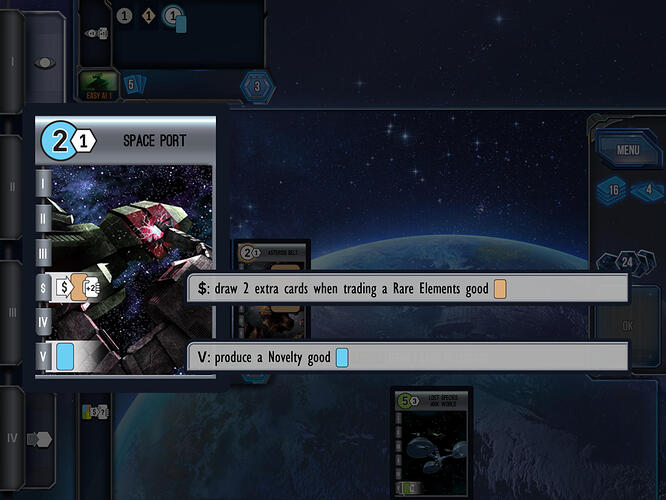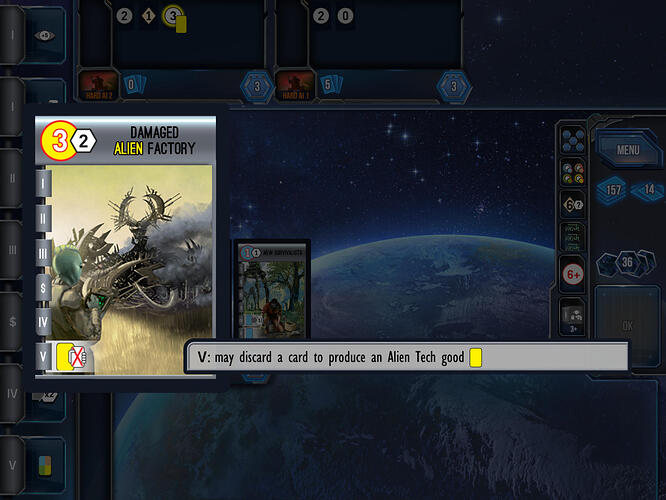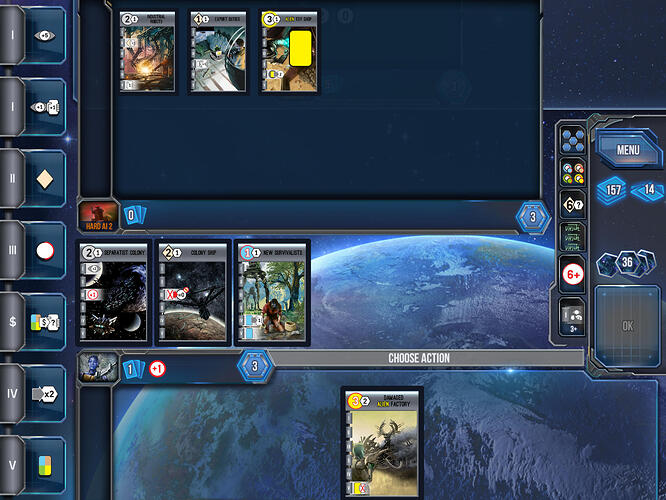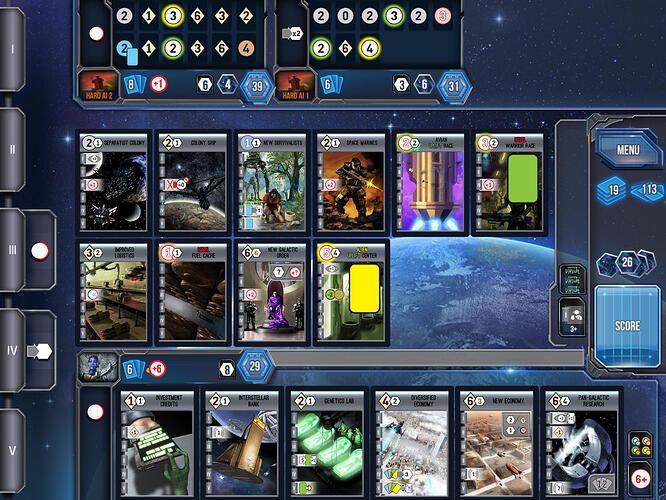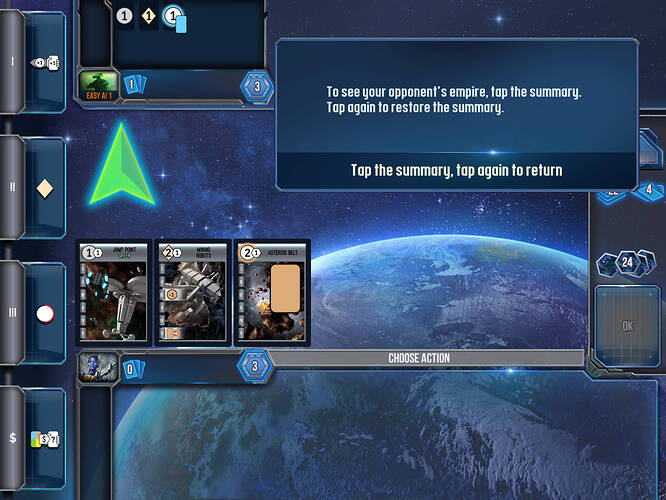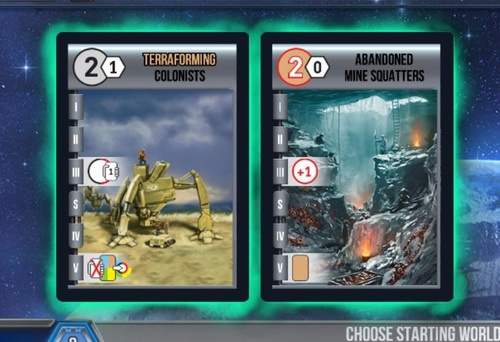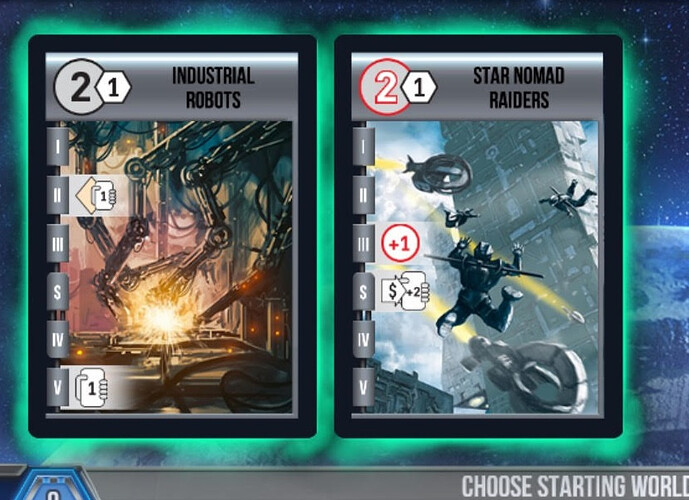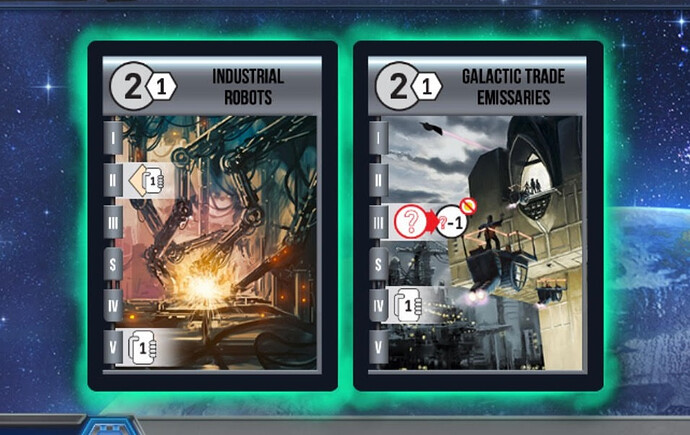Originally published at: http://statelyplay.com/2017/05/03/review-race-for-the-galaxy/
iOS Universal, Android •
When 2017 started I had already been girding my loins in preparation for a certain card game that was originally released in cardboard form back in 2007. Yes, 2017 was to be the year that I finally left my family behind and started the cult of Vlaada, continuously playing the digital version of Through the Ages. Things have changed. While I’m still planning on abandoning my family for a 2007 card game, it looks like it might be Race for the Galaxy instead of the aforementioned civ builder. RftG is out and, yes, it’s that good.
Despite their vastly different themes, Race for the Galaxy can trace its lineage back to the fertile plantations of the venerable euro board game, Puerto Rico. Designer Tom Lehmann was tasked with creating a card game based on PR and several of his ideas eventually appeared in the Puerto Rico card game officially known as San Juan. He took the remainder of his ideas and dumped them into a sci-fi game with a 4X vibe that was eventually polished to a mirrored shine in Race for the Galaxy.
[caption id=“attachment_1976” align=“aligncenter” width=“2048”]
Space Port. Your buyer of whoopee cushions and Groucho glasses.[/caption]Race for the Galaxy predates Dominion by a year so, thankfully, it’s not a deck-builder. Instead, RftG is a classic card game in which you’ll play cards down in front of you while your enemies do the same. There’s very little in terms of interaction, which is one criticism often leveled at RftG. If you go into it knowing that each player is racing to build the best engine rather than blowing each other up with death rays, the gameplay fits perfectly.
Cards have multiple roles depending on their location. They can be worlds you’ve settled or projects you’ve completed if played in your tableau, or they can represent raw materials that your planets produce. In your hand they act as money, used to pay the cost of building or settling. Wrapping your head around the card’s variable nature is a large part of overcoming RftG’s learning curve.
[caption id=“attachment_1977” align=“aligncenter” width=“2048”]
The Rosetta Stone of RftG.[/caption]The remainder of the learning curve involves deciphering a series of icons that even Champollion would have trouble unraveling. The cardboard RftG was notorious for scaring newbies away due to the lack of text and these intricate hieroglyphs. While the digital version still thrusts its icons front-and-center, a simple tap on each card reveals what the icon means in plain english, making the icons less of a hurdle. Once you play a few games with each icon explained, understanding the icons soon becomes second nature.
Gameplay involves each player secretly selecting an action and then revealing them simultaneously. Only the actions selected by players will be performed that turn, but all players will get to perform said action with the player choosing it getting a benefit. For example, one action is “Development” and it allows you to build a development card from your hand. If I select Development but my opponents do not, we all get to perform the Development action but I get to build mine with a discount. There are five actions to choose from, and part of the fun is guessing what your opponent might pick. Really need to Settle, but also want to Trade? Maybe your opponent will pick one of those, allowing you to pull it off while selecting the other action you needed this turn.
[caption id=“attachment_1978” align=“aligncenter” width=“2048”]
So many choices…[/caption]Other than that, it’s a Victory Point chase. VPs are gained by settling new planets either peacefully or via your military. You also get VPs from building developments which, apart from generating VPs, also usually give you benefits in one or more phases of the game. VPs can also be earned by generating and selling goods or by being the first to accomplish certain goals during a game (if you have the expansions…see below). While this all sounds like it plays like a 4X space romp, be aware that RftG is firmly set on the euro game side of the aisle. The theme is somewhat pasted on, and most of the game will have you focusing on your own hand and tableau and not even paying attention to what your opponents are doing. That’s not a knock, it’s just the kind of game RftG is.
[caption id=“attachment_1979” align=“aligncenter” width=“2048”]
When did the galaxy get so damned crowded?[/caption]Simply bringing the gameplay to life probably would have been enough, but Temple Gates’ port of RftG goes the extra mile. The AI is crated by Keldon Jones who has been working on a neural net AI for RftG since soon after its release. After years of polishing and learning, the AI in RftG is about as perfect as you can get in a mobile title. The easy AI is just that, and should only be a threat to newcomers. The medium AI will give intermediate players a run, but they should still be able to compete and win some of the time. The hard AI is for the pros. I’ve had RftG on my shelf since 2007, have played it a bunch, and the hard AI has no problem showing me the door. It’s smart and will give good players a run for their money. On top of that, there is online multiplayer that can be played either in real-time or asynchronously. Multiplayer has been working perfectly during the beta with players assigned a “friend code” which they can share with others to be added to their friend lists. The only downside is that the friend code doesn’t seem to be the same between devices, so your games will not carry over between phone and tablet. Also, there doesn’t appear to be any indication for which players are currently online, so you’re never quite sure if your opponent is still taking their turn or logged off. Even if you don’t have any friends, you can always select a quick game option and be paired with randos from around the world.
[caption id=“attachment_1980” align=“aligncenter” width=“2048”]
The tutorials are brought to you by Starfleet.[/caption]Otherwise, the app is flawless. The UI is smart and intuitive, the graphics are sharp and, even on the smallest devices cards, can be tapped to zoom and see their details. There are a series of three tutorials to get rookies up and running, and both The Gathering Storm and Rebels vs. Imperium expansions are available at launch for purchase, adding new mechanisms such as goals and takeovers. Even without the new mechanisms, you can simply add the cards from each expansion, increasing your options in each game. Apart from adding in expansion content, you also have the choice to play 2-player games with the standard rules or the advanced 2-player rules in which players get to choose 2 actions per turn.
[caption id=“attachment_1981” align=“aligncenter” width=“2048”]
Get used to seeing this.[/caption]Race for the Galaxy was one of the games gobbled up by Goko back when that debacle was news, and it seemed unlikely that a mobile version would ever make it to the App Store. Yet, here we are with a brilliant version of RftG on our devices courtesy of a developer that most of us had never heard of. Here’s hoping that Temple Gates has more board game wonders in store for us in the future. They’re too good at this for RftG to be their only cardboard port on the App Store.
